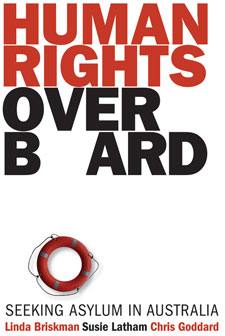In a recent Sydney Morning Herald Immigration Minister Senator Chris Evans was quoted as acknowledging the deleterious health impacts on physical and mental wellbeing of long-term detention, from a speech he made in July 2008.
In an interview soon after, a Chinese lady who has been in a Villawood detention centre for six and a half years, and now in community detention, has highlighted the plight of many refugees in detention at the hands of the Australian government.
Detained initially in January 2001, the woman has served more time in an Australian detention centre than any other person.
 Speaking publicly, through a translator, for the first time, the once successful Hong Kong entrepreneur said, “I have suicidal feelings. After eight years my mental health has gone. How much longer do I have to wait?...With my health the way it is if they send me back, I would die in prison".
Speaking publicly, through a translator, for the first time, the once successful Hong Kong entrepreneur said, “I have suicidal feelings. After eight years my mental health has gone. How much longer do I have to wait?...With my health the way it is if they send me back, I would die in prison".
The senator this year personally reviewed, together with the Commonwealth Ombudsman, all long term detainees in the system. Her case has been rejected in the Refugee Tribunal and the Federal Court and most recently was refused ministerial intervention. She has now appealed to the United Nations Human Rights Committee.Her situation highlights the human face behind just one of many stories of detention in Australia.
Human Rights Overboard draws together the oral testimony and written submissions from a citizen’s enquiry into Australia’s immigration-detention facilities. After the Cornelia Rau scandal in 2005 this citizen’s enquiry was launched. Until then the Federal government had refused to conduct a large-scale investigation into immigration detention and the operations had been largely shrouded in official secrecy.
The People’s Enquiry into Detention (as it was later called) gave gut-wrenching evidence about the journeys of asylum seekers to Australia, subsequent determination processes and their lives in detention. Around 200 people testified and a similar number of written submissions were received. The resulting report presents a powerful indictment of Australia’s refugee policy. Voices of former and current detainees, refugee advocates, lawyers, doctors, psychiatrists and former immigration and detainee staff are heard.
In early October this year the Sun Herald also reported that the Federal government is continuing to pay $30 million a year to maintain the new Christmas Island facility even though it has never been used, nor is it likely to be.
The 14 current detainees on the island are staying in the old smaller facilities. This smaller centre has only housed a total of 219 people processed over the last four years, the report stated. The senator said that the government had inherited the new centre built by the previous government, at a blow out cost of $396 million.
In an article by political correspondent Kerry-Anne Walsh on October 5, she revealed that the only people to visit there during the past year have been guards, maintenance workers and a 10-person federal parliament delegation. She also stated that senator Evans had pledged a month prior “to bring more humanity back to the way Australia deals with asylum seekers after the much-criticised John Howard era.”
The authors of this comprehensive and deeply disturbing book are Professor Linda Briskman, the Dr Harushisa Handa chair of human rights education at Curtin University, Susie Latham, an adjunct research associate at the Centre for Human Rights at Curtin University and Chris Goddard, the Director of Child Abuse Research Australia at Monash University.
Prominent humanitarian lawyer Julian Burnside writes the foreword and he calls the book an “unflinching look at disgraceful events”.
It's very clear and haunting story which will touch the heart of any person who defends/supports human rights and social justice, close to our own back yard. This is an essential book that will resonate for years to come.
















